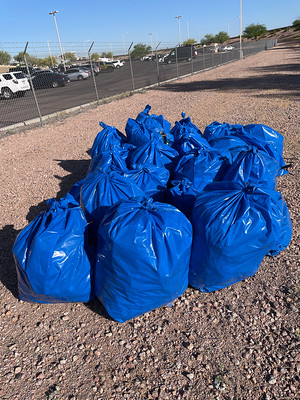When you drive past an active highway construction zone, you may see many men and women wearing brightly-colored reflective vests, operating heavy equipment or putting up signage to direct traffic and keep motorists safe.
But, there are people working behind the scenes to ensure that those projects run smoothly. Cordell Yazzie, a senior resident engineer at ADOT, is one of those people.
During National Engineers Week, we’re asking engineers on some of ADOT’s projects to talk about their work and careers. Let us introduce you to Yazzie, who works out of our Northcentral District in northern Arizona.
Why did you become an engineer and the type of engineer you are?

I am a civil engineer. I grew up interested in construction work because my maternal grandpa and father worked construction ever since I could remember. I graduated in 2009 from NAU with a Bachelor’s degree in civil engineering and later graduated from UA with a Masters of Science in civil engineering and engineering mechanics.
When did you join ADOT and what has been your track since then?
I joined ADOT in January 2019. I started off as a resident engineer for the North Central District and was promoted to senior resident engineer in November 2022. I’m currently working on the I-15 Virgin Bridge No. 1 replacement project in conjunction with several smaller projects.
What do you do as an engineer and what projects have you worked on at ADOT?
My first major project was working as the resident engineer on the Bellemont Bridges Deck Replacement. ADOT and the Federal Highway Administration wanted to replace the bridge decks for two separate bridges over Interstate 40 at Exit 185, approximately 13 miles west of Flagstaff.
My role was a blend of administrative work and oversight responsibilities. I monitored the work progress, reviewed contractor payments, documented changes and ensured compliance with state and federal regulations. I also oversaw construction activity and ensured quality control and assurance went well by communicating constantly with the project team.
Perhaps most importantly, I looked over the contract documents — which are the plans, the specifications — and made sure I understood it and interpreted it as best as I could with the contractor and the assigned field staff. The entire project team had to stay on schedule and complete the two bridge decks within time and within or under budget.
That project really made me learn about ADOT’s processes and procedures when change does occur. I had always learned to construct what was called on the plans and to not change them unless they were reviewed thoroughly and agreed upon. But the contractor proposed a value engineering deck construction technique that basically slid each bridge deck into place as opposed to constructing a bridge deck in several elements. The construction technique reduced costs and construction time, which was a benefit to the traveling public.
I also worked on the I-40 Fourth Street Bridge Project in 2020. With that project, and others I’ve worked on, I had to problem solve and work with all who were associated with the project, such as nearby stakeholders, to execute what the designer wanted. For example, sometimes a project plan may provide traffic control plans in general, so the nuts and bolts of figuring out how, when and where to place the traffic control devices in coordination with the correct project phasing is essential to keeping the traveling public and construction personnel safe.
What does working at ADOT mean to you?
Working for ADOT is great because I get to help keep the traveling public safe. I like completing roadway construction projects which assist in continuing, preserving or rehabilitating roadways and roadway features. I get to be a part of work activities that help people and essential products travel safely to their destinations throughout the country. Also, I work with many different engineering disciplines with very diverse backgrounds where continuous learning happens at all stages — from project development to construction. I love that I collaborate between project stakeholders and contractors because I constantly learn from each individual I come in contact with.
What advice do you have for young people considering a career in transportation engineering?
Go to school and be present daily. Listen, pay attention, understand, and believe that you can do it and most of all keep trying. Set firm goals in the engineering discipline direction you want to pursue and build on that. It’s taken me roughly 18 years to get to where I’m at, and I still use the same principles.









 The bags are filled with Ultra-Lightweight Foam Glass Aggregate. This unique material, which is made from 100 percent recycled glass, is being used at 19 locations throughout the project corridor.
The bags are filled with Ultra-Lightweight Foam Glass Aggregate. This unique material, which is made from 100 percent recycled glass, is being used at 19 locations throughout the project corridor. 



